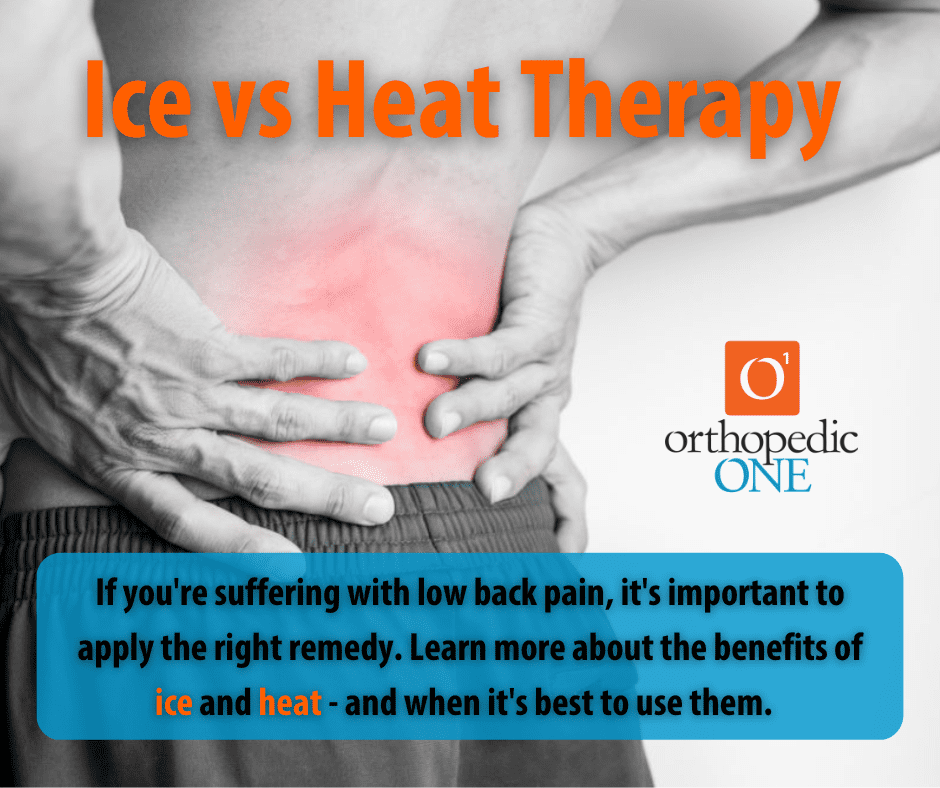SHOULD I USE ICE OR HEAT TO REDUCE MY LOW BACK PAIN?
There are many types of therapies that can bring relief to our lower back. Ice and heat are some of the most commonly used at-home therapies, yet often overlooked despite their ease and accessibility.
It’s important to know that the appropriateness and benefits of applying ice or heat can vary and that every situation is unique. Start with an understanding of the type of lower back pain you are experiencing and its cause. This will help you determine if and when ice or heat should be used in order to get the most benefit and reduce pain.
Types of low back pain that benefit from Heat or Ice
- Chronic Conditions, such as: Herniated or Degenerated Discs, Spinal Stenosis, and Spondylolisthesis
- Sports injuries, sprains, falls, or something directly impacting your lower back (ie. twisting injury from swinging a golf club)
- Pulled back muscle from excessive strain or force (ie. lifting weights)
- Exercise induced muscle soreness from overdoing a specific exercise or exercising without warming up
Which is best for you?
- In regard to acute back pain, or pain you experience due to a direct injury, it is best to start with ice therapy. An acute injury is one that lasts less than a 4-week duration. By using ice first, you are lowering your body’s temperature which will reduce inflammation and swelling, constrict blood vessels and help numb the area. After doing ice therapy first, and once the inflammation has been reduced, switch to heat therapy. Using heat therapy will improve the flexibility of soft tissues, movement of muscles, and overall functionality of the injured area. Once you’ve changed to heat therapy, apply on and off for several hours, even days to continue improving your tissue.

- When addressing chronic back pain – back pain that lasts more than a 4-week duration, you want to use heat therapy that provides constant warmth to the injured area. Examples of this include using a heating pad or a heating adhesive wrap that lays over the area, providing several hours of low-level heat therapy. When using this technique, make sure to monitor how long you are applying heat. Prolonged exposure to heat can lead to skin irritations and potentially skin damage.
- Another reason to consider using ice and heat therapy is after a workout or after putting extensive strain on your lower back. After completing a workout, or any type of physical movement we may start to experience soreness that spreads in to our back. This soreness can sometimes last several days long. When you first notice your soreness expanding to your lower back, it is important to start ice therapy immediately. This should reduce tissue damage, inflammation and pain. If the soreness continues after one day, switch to heat therapy. Switching to heat therapy should encourage tissue healing.
Heat and Ice Therapy can both be extremely beneficial when used correctly. These techniques become even more impactful when they become a part of our daily routine. Several ways we can incorporate the use of these therapies into our everyday lives is by taking a hot bath, laying on a heating pad at night before bed, applying a cold compress before you start your day, using coolant sprays like Icy Hot, or carrying heat or ice packs with you so you can use them while driving or at work.
When NOT to use Ice and Heat
This type of therapy should not be used when the injured area is open, bleeding, or there are any fluids coming out of the area. Heat therapy can also be dangerous when used to treat these conditions: Spinal Cord Injuries, Multiple Sclerosis, and Rheumatoid Arthritis.
In most situations, Heat and Ice are effective therapies to reduce pain and aid recovery from lower back pain.
It is an easy technique to use and most patients have access to ice or heat therapy at home, making this an effective choice for at-home treatment.